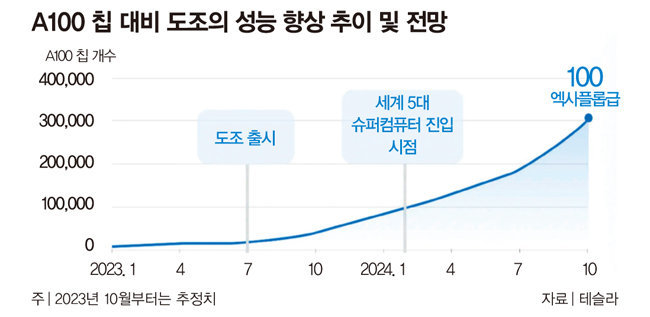Developed for the purpose of innovation in autonomous driving technology… Can also be applied to humanoid robots and cloud supercomputers
Tesla’s corporate value is rising rapidly as its self-developed supercomputer ‘Dojo’ has been in operation since July. Morgan Stanley, an American investment bank, estimated that Tesla’s corporate value could reach up to $500 billion (about 665 trillion won). Morgan Stanley said in a report, “Tesla Dojo will drive groundbreaking advancements in autonomous driving technology and product development,” and “It could help Tesla expand into other industries where computer vision is important, such as healthcare, security, and aviation.” “He claimed.
Tesla Supercomputer Dojo was developed with the purpose of dramatically increasing the training speed of artificial intelligence (AI) required for autonomous driving and improving the accuracy and performance of AI-based software. Dojo processes real video data generated from Tesla vehicles and data obtained from simulations and trains AI. For this purpose, Tesla vehicles have a built-in FSD (Fully Self-Driving) chip.
More powerful supercomputer-level systems are needed to utilize and process all the data generated by self-driving cars. Whenever a Tesla vehicle moves, a huge amount of data, up to 19 TB (terabytes) per day, is collected in the background through various sensors and cameras. This is because all information obtained from the vehicle’s 12 sensors and 8 external cameras installed to provide 360-degree visibility at a range of up to 250 meters is accumulated as data. Tesla currently offers a camera-based Autopilot feature. Autopilot, launched in 2017, has been used to strengthen the FSD function by collecting data with consent from the driver and then feeding it to a neural network. Tesla currently collected 300 million miles of driving data through the beta version of FSD in the third quarter alone. Dojo will utilize the massive amounts of video and sensor data generated by Tesla’s Autopilot and FSD features. Dojo uses this vast data to train neural networks to create more sophisticated autonomous driving algorithms.
Tesla has previously been running its autonomous driving training system using NVIDIA’s graphics processing unit (GPU) A100-based supercomputer. However, as dependence on NVIDIA hardware gradually increased, difficulties arose as it became difficult to meet the demand for chips from NVIDIA on time. This is why we set out to develop our own customized supercomputer.
A supercomputer project begins with the development of a basic element, an AI chip. Tesla has been developing its own chips for self-driving cars about five years ago. In 2019, the D1 chip was released and began to be installed in Tesla Model S, Model 3, and Model X. D1 is a high-performance chip used in machine learning and is designed for autonomous workflow and analysis. Equipped with a dual neural network array, it can process 72 trillion operations per second. Compared to the NVIDIA A100, despite its small size (645㎟), it has 15% higher computing power and 5 times faster bandwidth. Dojo’s D1 chip consists of several system trays and is integrated into a supercomputer. According to Tesla, Dojo can perform ExaFLOPS, or 1,018 floating point operations per second. This is the ability to process in just one second the amount of calculations that would have to be performed once every second for 31,688,765,000 years. Tesla CEO Elon Musk claims that by connecting multiple exaflops into a cluster, a more powerful supercomputer called ‘ExaPOD’ can be created in the long term. To achieve this, six D1 chips are combined to form a system tray. Next, stack two trays together in a computer cabinet that can manage 100 petaflops (performing 1015 operations). If 10 of these cabinets are used together, it is possible to overcome the exaflop barrier and form an exapod.
![The high-performance D1 chip that became the basis for the supercomputer Dojo. [테슬라 제공]](https://dimg.donga.com/wps/NEWS/IMAGE/2023/09/28/121418357.2.jpg) The high-performance D1 chip that became the basis for the supercomputer Dojo. [테슬라 제공]
The high-performance D1 chip that became the basis for the supercomputer Dojo. [테슬라 제공]
Tesla announced through Twitter ( Tesla plans to invest more than $1 billion (about 1.32 trillion won) in Dojo development by the end of 2024. At Tech Day 2021, Musk revealed the D1 chip and future Dojo development plans, emphasizing its identity as an AI company that integrates software and hardware, rather than a simple electric vehicle company. Considering the ability to quickly process the enormous amount of information that supercomputers will provide, Dojo has endless applications beyond Tesla cars. Bandwidth could also be provided to Tesla’s non-vehicle projects, including humanoid robots. Recently, it has been reported that a scenario of using Dojo as a commercial cloud SaaS (Software as a Service) supercomputer is being considered. The plan is to build a cloud system with Dojo and generate huge profits like Amazon’s AWS cloud service.
Adam Jonas, an analyst at Morgan Stanley, said, “Network-related services such as Tesla’s cloud using Dojo could become a source of revenue for the company.” “By enhancing Neuralink’s future prospects, it will ultimately become a path to achieving ‘Muskonomy’ (a combination of Musk and Economy),” he said.

*If you search and follow ‘Magazine Jin Donga’ and ‘Two Avengers’ on YouTube and portal sites respectively, you can find a variety of investment information such as videos in addition to articles.
《This article
Weekly Donga Room 1408
It was published in》
Lee Jong-rim, science reporter
Source: Donga
Mark Jones is a world traveler and journalist for News Rebeat. With a curious mind and a love of adventure, Mark brings a unique perspective to the latest global events and provides in-depth and thought-provoking coverage of the world at large.